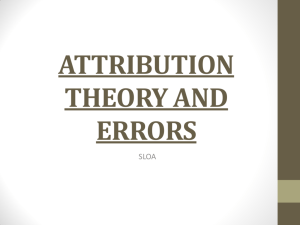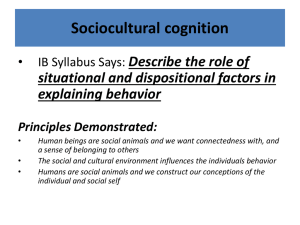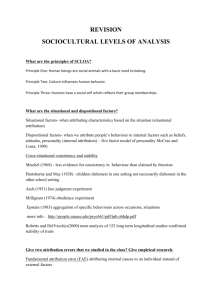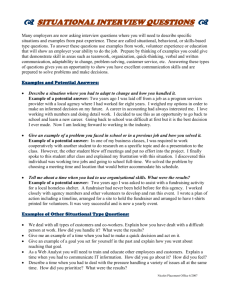Excerpt from - Pegasus @ UCF
advertisement
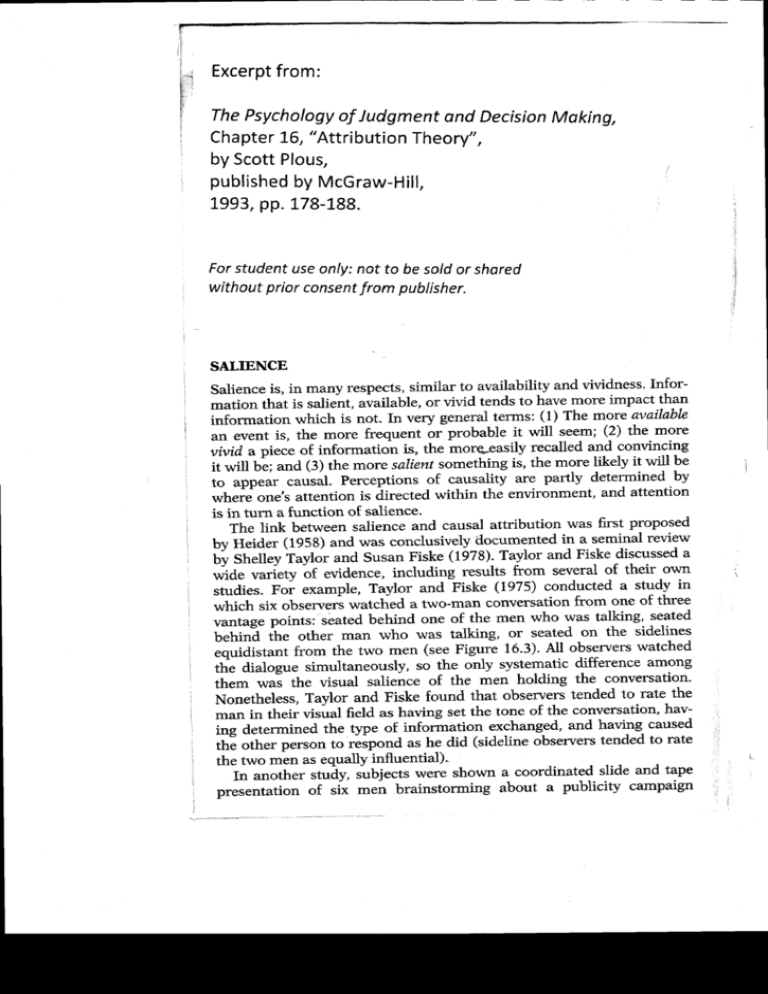
I
Excerpt
from:
lr..t
j
I
I
h.,'
fi
Il ThePsychologyof Judgmentand DecisionMaking,
l
ChapterL6,"AttributionTheory",
by ScottPlous,
published
by McGraw-Hill,
1993,pp. 178-1.88.
For student use anly: not to be soldor shared
without prior consentfrom publisher.
SALIENCE
Salience is, in many respects, similar to availability and vividness' Information that is salient, available, or vivid tends to have more impact than
information which is not. In very general terms; (t) The more available
(2) the more
an event is, the more frequent or probable it will seem;
i,tuid upiece of information is, the more*easily recalled and convincing
it will ue; *d (3) the more salient something is, the mgre likely it will be
by
il upp"* causal. perceptions of causality are partly determined
*her" one's attention is directed within the environment, and attention
is in turn a function of salience.
proposed
The link between salience and causal attribution was first
by Heider (1958) and was conclusively documgnted *3 seminal review
a
UV Sfr"ff"V Taylor and Susan Fiske (1i7S). Taylor and Fiske discussed
own
.1,,uri*ty
of
their
several
from
tf *nid"tt"e, including results
#a"
Taylor and Fiske (1975) conducted a study in
example,
For
studies.
which six observeri watched a two-man conversation from one of three
points: seated behind one of the men who was talking, seated
"""tug"
behin-d ihe other man who was talking, or seated on the sidelines
from the two men (see Figure 16.3). All obsewers watched
"qniairt"tt
tti. diulogue simultaneously, so the only sysleln-atic difference among
them wai the visual salience of the men holding the conversation'
the
Nonetheless, Taylor and Fiske found that obsewers tended to rate
man in their visual field as having set the tone of the conversation, having d"t"r-ined the type of inforrnation exchanged, and having caused
rate
th! other person to tespond as he did (sideline observers tended to
the two men as equally influential)'.
tape
In another study, *bj""rc were shown a coordinated slide and
brainstorrning about a publicity campaign
pr"r.rrtution of rX -"t
i
)
,
ATTRIBUTION THEORY
I79
16.3
FIGURE
by shelleyToylor ond suson
This diogrom showsthe seotingorrongemenlin on experiment
PersonB. ond two observers
foced
Fiske[t975). Two observersfoced PersonA, two observers
B. Toylorond Fiskefoundthot
in the conholgroup sot equidistonfbetweenPersonA ond Person
observersroted the personthey foced os mostinfluentiol'
(Taylor, Fiske, Close, Anderson, & Ruderman' 1'977)'In one expenmenpaired.with the photo;
iat fonaltion, each Jf the voices on the tape was
were paired
g*ph of a white *J"t i' u ,"to"d condition' three voices
if'"" with black males; and in a third condition'
with white males
(the same sound""J
the voices Were paired with five whites and one black
hypothesis that
the
with
track was used in all three conditions). rn line
p"r""ived as more influential, Taylor and her colsalient individual,
lhe ione black in the third condition was perceived as
found that "ru
i;g*cleater impression
l"ifi"g more, being more influential, and giving a
(when he was less
than the same p"rJo' in the context of other blacks
thing was perr"fi"t l. Thus, ih" rr"ry same person saying the very same
he was the only
ceived as talking more and being *ot" influential when
black in the grouP.
observed people
Additional studies have manipulated the salience of
shirt as opposed
in other ways-by having them wear a boldly patterned
180
HEURISTICS AND BIASES
to a grey shirt, by having them rock in a rocking chair instead of sitting
moti6nilss, or by having them sit under a bright light versus a dim
light-and the results have tended to be the same (McArthur & Post,
tgZZ). Salient people are perceived as relatively causal. In fact, one
study even found that when people were seated in front of a large mirror,
they tended to view themselves as more causal (Duval & Wicklund,1973)'
THE FUNDAMENTAL
ATTRIBUTION
ERROR
In his landmark work The Psychology of Interpersonal Relations, Heider
(1958) observed that "behavior engulfs the field." What he meant by this
statement is that the most salient thing in a sociai setting is behavior
(and, by implication, the "actors" who are behaving). Situational factors, such u, .oo* temperature or the time of day, are generally secondary. People are in the foreg;:ound; most everything else is in the
background.
In 1977, Lee Ross argued that this focus on actors and their behavior
leads observers to o',r"ritt ibute behavior to dispositional factors-such
as abilities, traits, and motives-and underestimate the influence of situational factors" In fact, Ross contended that this overreadiness to
and
explain behavior in terms of dispositional factors is so widespread
universal that it should be called "the fundamental attribution error'"
The reason for labeling this tendency as an efYor, rather than simply an
attributional bias or difference"bf opiniorg'is that dispositional attributions are often patently incorrect (Reeder, 1,952).For example, Alhrl
Gg73) found that people judged highly obediMiller and his
"oll"ugnlr
(1963)
stud"yto be relatively cold, maladjusted,
i ent subjects in Milgrim's
I and aggressive,even though this was cleariy not the case'
I
eaaitional evid"rr"" ofo.rrerattribution comes from the first attitude
by Ned
i attribution study ever pubtrished,.In this experiment, conducted
an
essay
with
presented
were
(1967),
subjects
, Jones and Victor }tarris
particular
a
take
written by someone who was either expiicitly forced to
position or someone who had "free choice" in selecting a position. Even
to
*h"r, subjects were expressly told that an essay's author was forced
to
the
p,osition
that
attribute
to
take a particular position, they tended
: author. This finding is very robust and has been replicated in a number
' of different studies (Jott"t, 1979; Snyder & Jones, 1974)'
as
The fundamental attribution error can be extremely persistent,
'
in
their
(1982)
illustrated
Paula Pietromonaco and Richard Nisbett
, study "swimming Upstream Against the Fundamental Attribution
Pietromonlacolnd Nisbeti presented roughly half their subjects
I ;;;;."
, with an abridged version of the oailey and Batson (1973) study of semilate
nary studentJwho failed to help a man in need because they were
(discussed
in
to !irr" a lecture on the parable of the Good Samaritan
the situational
, Chipter 5). In that study, ft"bittg behavior depended on
ATTRIBUTIONTHEORY
181
factor of hurriedness rather than the dispositional factor of religiosity
(63 percent of the students helped when they were under no time preswith only 10 percent when they were extremely rushed)'
r,r.",
"o*pared
The rest df Pi"tro-onaco and Nisbett's subjects were not told about the
i results of Darley and Batson's experiment. All subjects were then given
two scenarios similar to the one in Darley and Batson's study, and they
i were asked to estimate the percentage of people who would stop to help
the victim in each scenario.
Pietromonaco and Nisbett (1982) found that subjects who were
, unrware of the study by Darley and Batson (1973) fell preyto the fundamental attribution *tt*. Theytended to predict helping behavior onthe
basis of religiosity (a disposiiional factor that was actually unrelated to
itseli, this finding is unremarkable; not knowing the orrthelpine),
"ot n/
Ua.t"y and Batson's study, m,ost people would assume that
,
"ori."
It"ipi"g
is a function of dispositional factors' More surprising-is the
that subjects who t"ud Xbont Darley and Batson s study aiso
fi*il;
were not
relied-on religiosity to predict helping behavior.Indeed, they
factors than subjects
: significantly l-e.s lnclined to rely on dispositional
Batson.
wf,o
-ih;"knew nothing about the study by Darley and
I
results i'ho* once agaitt thtt base rate information is often
error may be
ignored, and they suggest thatlhg fundamental attribution
people,are-explicitly told ab-out the
i very resistant to chaile. Even when
make dispositional attributions
I pressures present in one situation, they
have
i for behavior in related situations. Although some researchers
"fundamental"
as
argued that the furrdum.rrtal attribution error is not
1981;
Quattrone, 1982;
&
Yarkin,
asiriginalty suspected (Harvey, Town,
overatfrequently
, TetloJk, rg-SSa),there is no question that observers
tribute behavior to dispositional factors'
MY SITUATION
IS YOUR DISPOSITION
what engulfs the
If the behavior of an actor engulfs the observer's field,
that actors focus on the situation
, u",Oir field? The answer seems to be
themselves behave in
i at hand. only in rare situations do actors watch
: the same waY observers do.
tend to explain
As a consequence of this difference in focus, actors
often than do
more
factors
I their behavior as a function of situational
(I97t, P, ?),
Nisbett
obsewers. According to Ned Jones and Richard
observers: "The
who first noteJ int aiff"rence between actors and
condiactor's view of his behavior emphasizes the role of environmental
the
emphasizesview
tions at the moment of action. The observels
to
wish
We
actor.
the
,causal role of r;"bl; dispositional properties of
actions
their
;tg"" th;; thire is a pewisive tendeicy far actors to.attribute
i',,to
the same
attribute
to
tend
absenters
situational r"[uirements, whereas
,actions to stablepersonaldispositions'"
182
,
HEURISTICS AND BIASES
One of the best known studies on actor-observer differences in attribution was published in 1973 by Richard Nisbett, Craig Caputo, Patricia
Legant, and Jeanne Marecek. Nisbett and his colleagues conducted
three separate experiments, each of which found significant attributional differences between actors and observers. In one experiment, for
example, Nisbett and his associatesasked male college students to write
four brief paragraphs explaining (1) why they iiked the woman they had
dated most fr"equently during the past year or so, (2) why they had chosen their college major, (3) why their best male friend liked the woman
he had dated most regularly in the past year or so, and (4) why their
best friend had chosen his major. These paragraphs were then scored as
to how much they stressed situational factors versus dispositional factors. For instance, statements such as "She's a relaxing person" or
"Chemistry is a high-paying field" were scored as situational reasons,
whereas "I need someone I caln relax with" or "I want to make a lot Of
money" were scored as dispositional reasons.
Nisbett and his colleagues found that, when students explained why
they liked their girlfriend, they gave more than twice as many situational reasons (reasons that referred to characteristics of the woman) than
dispositional reasons (reasons that refened to their own needs, interesti, and traits). On the other hand, when they explained why their best
friend liked his girlfriend, they gave almost equal numbers of situational
and dispositional reasons. Sirniiarly, w}lgn students explained why they
had chosen their major, they listed roughly the same number of situational and dispositional factors. Yet they gave almost four times as
many dispositional reasons as situational reasons when explaining their
best friend's choice of major.
Averaging over the dating question and college major question, students tended to give more situational rOasonsthan dispositional reasons
for their own behaviors, but more dispositional than situational reasons
for the behavior of others. Or, putting the results another way, they
made nearly the same number of dispositional attributions for their
own behavior and the behavior of others, but made nearly twice as
many situational attributions for themselves as others. Nisbett and his
colleagues explained this discrepancy iargely in terms of differences
between the information that is salient to actors and observers.
In 1,982,David Watson published a review article closely examining
this issue. Watson wanted to know whether actor-observer difterences
were due mainly to a difference in making dispositional attributions, a
difference in making situational attributions, or both. What he found
was that in most studies, actors and observers both ascribed more
causal importance to people's dispositions than to situational factors. As
ut. (tgl3), though, actors and observers difin the study by Nisbelt
"t
fered in their tendency to make situational attributions. People were
much more willing to invoke situational explanations for their own
behavior than for the behavior of others.
Ar-rRrBUfiON THEORY
1g3
TRADING PIJ\CES
If actor-observer differences in attribution_are largely a
function of perspective, it should be possible to reverse these dirteiences
by swapf,ing
the perspectives of actors and observers. This was
the iogic behind a
study by Michael storms (1,973),in which actors-urrd
obr"*ers were
given an opportunity to trade places. storms filmed
a get-acquainted
conversation that two "actor-subjects" had in the presenie
of iwo off_
camera "observer-subjects."Each observer was assignedto watch
a dif_
ferent actor, and two- videotapes were made-one slot essentially
from
Actor 1's perspectivelooking at Actor 2, and another from Acto,
i,, p"._
spective,looking at Actor 1. Thirty foursomes , or 12a subjects in
all, iar_
ticipated in the experiment.
_After the get-acquainted conversation, subjects were assigned to one
of three experimental conditions: (l) the same orientation condition, in
which observers viewed a vjdeotape of the same actor they had been
watching, and actors viewed a videotape of their conversation partner;
(2-)the new orientation condition, in which observers viewed ,.riieotupe
of the actor they had not been watching (thereby adopting their
assigned
,actocs perspective), and actors viewed a videotapl oi themselves (adopting their observer's orientation); and (3) the io videotape
condition, in which subjects did not watch a videotape of the .on r.rrution.
Storms then asked subjects to rate the"degreeto which personal characteristics and characteristics of the situation had been responsible for
various aspects of the actors' behavior. Actors rated themselves, and
observers rated the actor they had been assigned to watch during the
get-acquainted conversation. what storms found is that subjects who
either watched a videotape from the same orientation or watched no
videotape at all displayed actor-observer differences in atrribution, but
subjects who viewed a videotape shot from the opposite perspective
showed a reversal of actor-observer differences in attribution (see Figure 16.4). From these results, Storms concluded that visual orientation
powerfully influences the causal attributions people make.
CLINICAL
IMPLICATIONS
Most of the research reviewed thus far points in the same direction:
when explaining the causes of behavior, people rely heavily on factors
that are saiient at t]netime. For observers, the actor is most salient: $or
the actor, situationai demands are salient. This seemingly minor distinction has profound implications. The difference between interpreting
be/ravior as situationally caused or dispositionally caused is critical in a
wide array of social judgments, including jury and parole board decisions, perceptions of battered wives, and explanations for scholastic failure (Frieze, Bar-Tal, & Carroll, 1979),
184
HEURTSTTCSAND BTASES
Actor ratings
(B
'd6
P
a
oJ
a
o+
:?
in
o
o
b0z
o
Same orientation
No videotape
New orientation
Experimental Condition
16.4
FIGURE
(Resu/ts
Attributionoldifferencesore reversedwhen ociorsond observersexchongeperspectives.
from a study by Michael Storms,1973.)
One area in which causal attributions are particularly critical is psychotherapy (Batson & Marz, 1,979;Ross, Rodin, & Zimbardo, 1969;
Shenkel, Snyder, Batson, & Clark, 1979; Snyder, 1977;Valins & Nisbett,
1971). Therapy is a special topic of .interest because treatment recommendations often depend directly on whether a client's problem is
attributed to situational factors or to the client's disposition (Batson,
1975i).If situational factors are responsible for the problem, then efforts
are frequently aimed at changing the situation. On the other hand, if
dispositional factors are to blame, then an effort is usually made to
change the individual. Unfortunately, this determination may have
more to do with a therapist's orientation and training than the circumstance in question. As a study I conducted with Philip Zimbardo shows,
attributional biases strongly color clinical inferences.
In this study, we used a mail survey to assessthe attributional style of
prominent psychoanalysts, behavior therapists, and a nontherapist control group. Respondents were asked to explain three hypothetical problems experienced by themselves, their closest same-sex friend, or a
client. For instance, respondents were asked how they would explain the
onset of a sleep disturbance with recurrent nightmares. These answers
were then rated along dimensions such as situational-dispositional and
physical-psycholo gical.
ATTRTBUTTON
THEORY
185
The results showed a number of interesting patterns. First, psychoanalysts tended to explain problems in terms of the sufferefs personality,
whereas behavior therapists and nontherapists tended to explain problems in terms of situational factors or a mixture of situational and dispositional causes. Second, when hypothetical problems were experienced by their friends or clients, psychoanalysts tended to see the
problems as psychological in origin, but when the same problems were
experienced by themselves, psychoanalysts explained them as physical.
Behavior therapists and nontherapists showed no such tendency. FinalIy, clinicians holding medical degrees made more physical attributions
and fewer psychological attributions than did clinicians with nonmedical degrees, These findings led us to conclude that "the selection of a
therapist may be an important factor in determining inferred etiology
and recommended treatment, independent of the actuai problem"
(Plous & Zimbardo, 1986,p. 570).
OTHER ATTRIBUTIONAL
BIASES
In addition to actor-observer differences in attribution, the fundamental
attribution error, and the tendency to ignore consensus information,
there are a number of other attributional biases that influence social
judgments. For example, people are more likely to accept responsibility
for successesthan for failures (Miller, L976; Mullen & Riordan, 1988;
Schlenker & Miller, 1977). Dale Milier and Michael Ross (1975) have
referred to this tendency as a "self-serving" bias in attribution, and
research suggeststhat it arises from a compiex combination of cognitive
and motivational factors (e.g,, false expectations, the desire to look
good, and the need to protect self-esteem).
A related class of biases, known,as "egocentric" biases in attribution,
have also been amply documented. Egocentric biases are those in which
people accept more responsibility for joint outcomes than other contributors attribute to them. Michael Ross and Fiore Sicoly (1979) conducted
the first empirical investigation of egocentric biases. In this research,
Ross and Sicoly asked 37 married couples to complete a questionnaire
about their relationship. Each member of the couple was asked to estimate how responsible she or he was for 20 different activities, such as
making breakfast, cleaning dishes, demonstrating affection, and so on.
trn 16 of these activities, egocentric biases were evident (i.e., when ratings from each member of the couple were added together, the total
exceededmore than 100 percent of the rating scale).
Although egocentric biases are sometimes simply a matter of claiming undue credit for positive outcomes and behavior, Ross and Sicoly
aiso found that they occur for undesirable actions. They discovered, for
example, that marriage partners tended to report causing as well as
resolving the majority of conflicts in their relationship. These findings
t 86
HEURTSTTCS
AND BTASES
suggest that egocentric biases are more than attempts at self-enhancement. In some cases, they may arise because one's own actions are more
avaiiable (more easily retrieved from memory) than the actions of other
people (Thompson & Kelley, 1981).
Another closely related bias is what Shelley Taylor and Judy Koivumaki (1976) have called the "positivity effect." The positivity effect is a
tendency to attribute positive behaviors to dispositional factors and negative behaviors to situational factors. In their research, Taylor and
Koivumaki presented married people with a list of positive and negative
behaviors committed by themselves, their spouse, a friend, or an
acquaintance. For example, positive behaviors included paying a compliment to soqneone, talking cheerfully to another person, and having
fun. Negative behaviors included having a heated argument with someone, being rude to someone, and forgetting to do something. Taylor and
Koivumaki asked subjects to rate the degree to which these behaviors
were due to situational or dispositional factors. What they found-regardless of who committed the behavior-was that positive behaviors
were attributed primarily to dispositional factors, and negative behaviors were attributed mainly to situational factors.
Of course, Taylor and Koivumaki did not ask subjects to explain the
behavior of people whom they disliked; if they had, an opposing "negativity effect" might have been observed (see, for example, Regan, Straus,
& Fazio, 1974).Indeed, Thomas Peftigrew (1979) has called a negativity
effect for disliked others the "ultimate attribution error." Fettigrew, a
widely respected expert on racial prejudice, warned: "When race and
ethnicity are involved, these attributions will take the form of believing
the actions to be a result of immutable, genetic characteristics of the
derogated people in general-the' bedrock assumption of racist doctrine" (p. a65).
Pettigrew's warning is based on more than hollow speculation. In
1976, Birt Duncan linked attributional biases with raciai prejudice. In
this experiment, white college students were asked to watch a videotaped discussion between two people who eventually had a heated argument. Toward the end of the videotape, one of the discussants shoved
the other. The experiment had four conditions: (1) black shover and
white shovee; (2) white shover and black shovee; (3) both discussants
white; and (4) both discussants black. Not only did subjects rate the
shove as more violent when it came from a black person than a white
person, but they tended to make dispositional attributions for black
shoving and situational attributions for white shoving.
One additional form of attributional bias-a bias that often reinforces
prejudicial judgments-is the tendency to ascribe less variability to others tlmn to oneself. This bias was first documented in Germany by
Daniele Kammer (1982) and was subsequently replicated in the United
StatesbyTerriBaxterandLewisGoldberg(1987).Kammerpresented
such as quiet-talkativeand
ttrit;;;6,
tipolar
diff;;;
20
with
subiects
friends
,ut"1ro* m,*h they and their
cautious-bold,and askedthem to
Kammer
ftom situation to situation'
varied along tlrese*Jiiie;;i;"r
peofotlndthatpeopleviewedtheirownbehavioraSmorevariableacross
Res.ur.h also.suggeststhat
beharrior.
theJil""al
than
situations
than others
multifaceied and lesspredictable willing to
ple seethemselve,;;;;;
tntt thev are more
(sande, Goethals,e il;ili*rgaal,-u;J
,rr"ltgrttt ."a feelings-to themselves
ascribe ternporary il;r;;"a.,
this relativelv undifr geg)lT;;;il'-of
than others twt'it"?vo""eer'.
g*J"t stereotvpesfl ourish'
oiot*h;;;;il'
ferentiatedlri"*
"tttii"l "ii
CONCLUSION
you usually
that happ.t" T y::l Do or do
things
the
explain
you
vou
traits'
How do
i"t""ttt"Tg
to a
specific
attribute them '" ;;;;;"";I="uiriii"''
typically
factors? 1r" tt " causes
time?
attribute them ," t"riria"
f-trv *r"u^r and stable-over
ri,"utioi'*oi;;;
particular
vo" meet a friend
U"i:ir""""t]t.'-(t)
onlrr-"i;;.h;;r""
This chap,.,
(2) yot qo out on a date and
on
you
Vo"'ulp"*unce;
who compliments
t"f;l};Aif:^T1tJiJ,:l:f#
(s)
erv.e
u,'a
vou
badlv;
it goes
":
of these scenarlo
Each
the audien"" '"t"* tttgatiirety'
by Martin seligman
euestionnairl'i"u"iop"d
sryI;
Attributional
the
Alrtmson' Metalslqy'
s"q'illl .,Ii"*"y"t'
i1"i"t*"'
colleagues
this questionand his
."a nir'"t"""i","t haveused attributional
rggz))slilil;;
& seligma",
a different
pti"pil #t"t
Marnaire to see *h";i;";;;;;""a
puptl' Lvr Abramson'
ffi;;;lt
stylethan'ota"p'i"JJ'p"opr" i" tb;*t- lrvpotft"titedthat depressed
rrla-i"irrt"ira"l"
global' and internat
tin Setigmur,,
in
people tend to ";;Jdi" negative
";"";;';'+able'
becausel stuck my foot
*""iutarv
late
the
mur"s ("'g., "^A';'J'
do
mvmouth,l.n"JJJhu!s"tig**."J-!i'collea8uessupportsthis
& von Baever' t979)' as
il**"f'
Abtt*to"'
stud(s"fig;;"'
than 100
hypothesis
"meta'-ttiiv'i';uased on'moiestvleis directlv
ttoii"ical
results
the
"' "il#;;;
o euil*v]'iq8zl.;ilb"tional
'J".lJ$le:::'n"ff
;ifjJ:J'h:*:ruft"#'Ji:ffi
fr:'Jlf
ies (sweeney,
*lr tr reducingthe funda".i*"rii"
ror
chapter.
informathis
in
outlined
to_consensus
"*urrlpl;;;
Jtoif
puy
to
i,
error
same
the
mentalattribution
whtn-co"ftonted bv
'i*iltfi
u*r'ut*'
tion. If most ;;;il
situation,.airp-o-Jti'oriJ.*pt"rrd'";'ilil;"prtu,'-atran{"d'Instead'
foi an explanationof bei;t;tt
i;;lo-ritruti#;i
,h""f
obsewers
behaved
have
-. :^
howvoU
askhnw
tt" would
to o.L
is +^
yffl:
technique
"debiasing"
'i1;; perspeu;ffi;
Another
n"."u,"i, suggeststhat
havior.
if thrust i"," ,n"-,"ire
circum""""".
!
188
HEURISTICS AND BIASES
(Galper'
tive-taking can reverse actor-observer differences in attribution
in
Totten, 1975). This technique will be discussed further
t976;R"e"'&
the Afterword.
factors happen
Because causal attributions often depend on whalevgr
hidden causes' John
to be most salient, it is also importani to look for
in wordntit.rr"ti rrir. (1977)iound that even minor changes
ilr,r";;"J
For
attributions'
causal
irg ..., influence salience and, in turn, alter
elicit
to
are more likely
example, statements ,u.h as "Fred likes the caf'
Fred,'r because Fred
by
liked
is
"The
car
Ji-rp"Iiri""al explanations than
the latter' This sensitivity to
is more salient in the former sentence than
with the research reviewed in Chapters 5
wording ir
;;;;i."
"""titt"ntcausal attributions are "plastic" in much the
and 6, and it ,"gg.r;,h*
same way as are other judgments"
